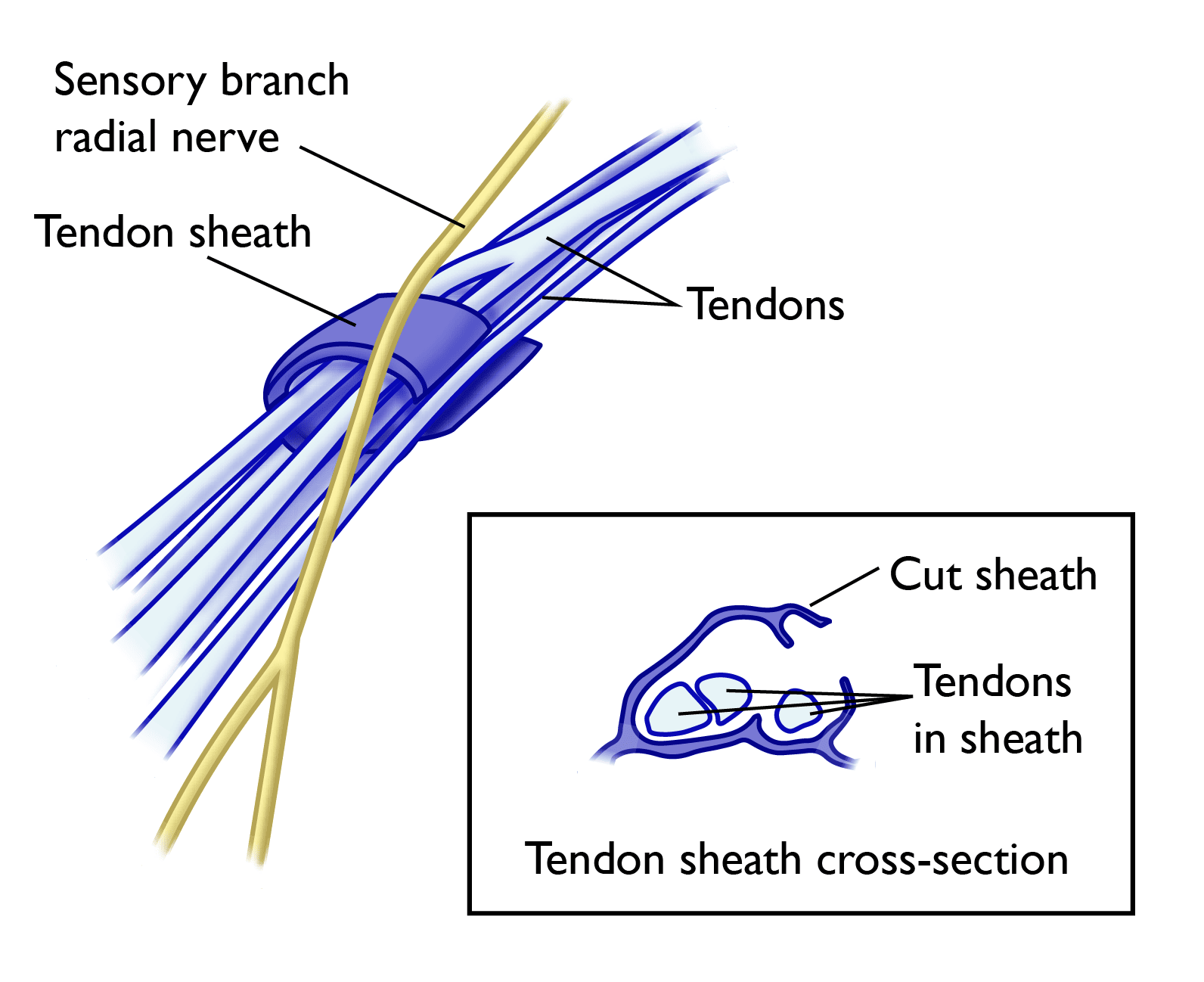Diseases & Conditions
De Quervain's Tenosynovitis
De Quervain's tenosynovitis is swelling of the tendons that run along the thumb side of the wrist and attach to the base of the thumb. This occurs when the tendons are constricted by the sheath that they run through to get from the wrist to the hand.
This condition can cause pain and tenderness along the thumb side of the wrist. This is particularly noticeable when you are:
- Moving the thumb
- Forming a fist
- Grasping or gripping something
- Turning the wrist
- Lifting something with your arms in front of you and thumbs pointed toward the ceiling (e.g., lifting a child)
Anatomy
De Quervain's tenosynovitis affects the abductor pollicis longus (APL) and the extensor pollicis brevis (EPB). These are two of the main tendons to the thumb that assist with bringing the thumb out away from the index finger (APL) and straightening the joints of the thumb (EPB). These two tendons arise from muscles in the forearm and then run together in a sheath that keeps them close to the bone as they cross over from the thumb side of the wrist into the hand.
Tendons are rope-like structures that attach muscle to bone, allowing the muscle to pull on and move the bone. Tendons are covered by a slippery and thin soft-tissue layer called synovium. This layer provides nutrients to the tendons and allows them to slide easily through the sheath that surrounds them.
Any swelling of the tendons and/or thickening of the sheath can result in a situation where the tendons no longer fit well inside the sheath. This results in increased friction and pain with certain thumb and wrist movements.
Causes
- De Quervain's tenosynovitis is common and may be caused by overuse of the thumb and wrist.
- It also is associated with pregnancy and breastfeeding.
- People with rheumatoid arthritis may be more susceptible to De Quervain's tenosynovitis.
- It is most common in people in their 40s and 50s and affects more women than men.
Symptoms
These are signs of De Quervain's tenosynovitis:
- You may feel pain over the thumb side of the wrist. This is the main symptom. The pain may appear either gradually or suddenly. It starts in the wrist and can travel up the forearm. The pain is usually worse when the hand and thumb are in use. This is especially true when forcefully grasping and/or lifting objects or twisting the wrist.
- You may see swelling over the thumb side of the wrist. This swelling may accompany a fluid-filled cyst in this region.
- You may feel a catching or snapping sensation when moving the thumb.
- Pain and swelling may make it difficult to move your thumb and wrist.
Doctor Examination
To determine whether you have De Quervain's tenosynovitis:
- Your doctor may touch along the thumb side of your wrist, looking for pain and swelling.
- You may be asked to perform the Finkelstein/Eichhoff test, which involves placing your thumb in your palm, grasping it with your other fingers, and bending your wrist toward your little finger. The test is positive, indicating you may have De Quervain's tenosynovitis, if you experience pain during the maneuver.
Treatment
De Quervain's tendinosis is treated by reducing the swelling/irritation of the tendons and tendon sheath, thereby relieving the pain caused by the condition.
Nonsurgical Treatment
- Splints. A removeable splint that keeps the wrist straight and the thumb still in a comfortable position may improve pain, especially when worn at night.
- Non-steroidal anti-inflammatory drugs (NSAIDs). Drugs like ibuprofen and naproxen can be taken by mouth or applied topically. They may help reduce swelling and relieve pain.
- Activity modification. Avoiding activities that cause pain and swelling may allow the symptoms to go away on their own.
- Corticosteroids. An injection of corticosteroids into the tendon sheath can be effective in addressing the condition by reducing swelling and relieving pain. One or two injections has been shown to relieve the condition in 50 to 80% of patients.
Surgical Treatment
Surgery may be recommended if symptoms are severe or do not improve with non-operative management.
The goal of surgery is to release the tendon sheath to make more room for the irritated tendons. When done correctly, this can relieve the symptoms of De Quervain's tenosynovitis without affecting hand/wrist function.
During surgery:
- The surgeon first identifies and protects the nerves that live near the tendon sheath.
- The surgeon then releases the sheath in a way that avoids tendon instability.
- If there is excess tissue (tenosynovium) around the tendons, the surgeon will remove it.
- The incision is then closed, and a bandage (and sometimes a splint) is applied.
Regardless of the treatment, you can usually resume normal use of the hand once comfort and strength have returned. Your orthopaedic surgeon can advise you on the best treatment for your situation.
Recovery
Most patients with De Quervain's tenosynovitis do very well and are ultimately relieved of their symptoms with nonsurgical and/or surgical treatment.
- Fifty to 80% of patients can be successfully treated nonsurgically with splints, NSAIDs, and injections.
- The remaining 20% of patients typically respond well to surgery.
Complications of surgery are rare. Patients with diabetes may be less successfully treated with injections and are more likely to have a surgical complication (infection, wound healing problems, etc.).
Contributed and/or Updated by
Peer-Reviewed by
AAOS does not endorse any treatments, procedures, products, or physicians referenced herein. This information is provided as an educational service and is not intended to serve as medical advice. Anyone seeking specific orthopaedic advice or assistance should consult his or her orthopaedic surgeon, or locate one in your area through the AAOS Find an Orthopaedist program on this website.









